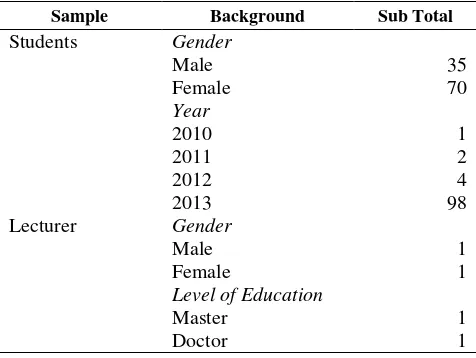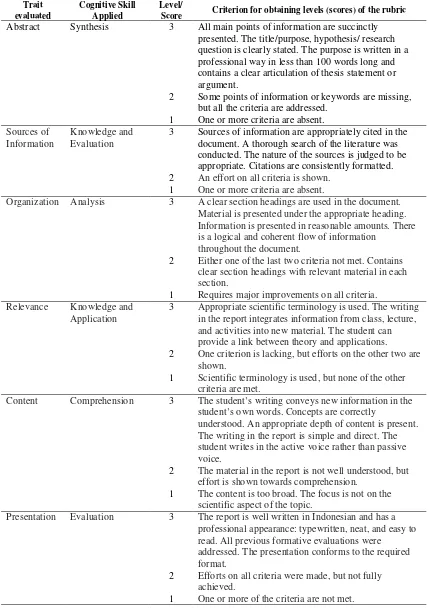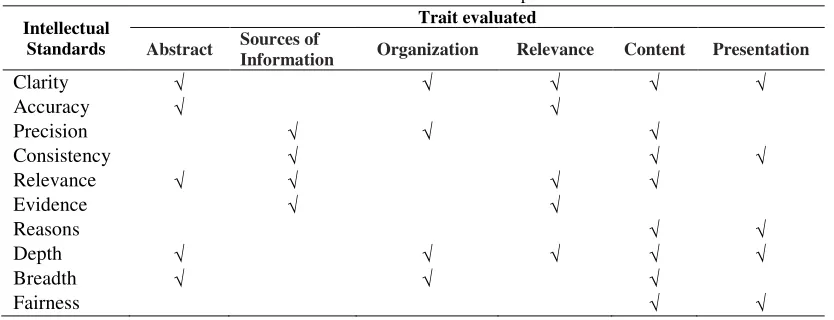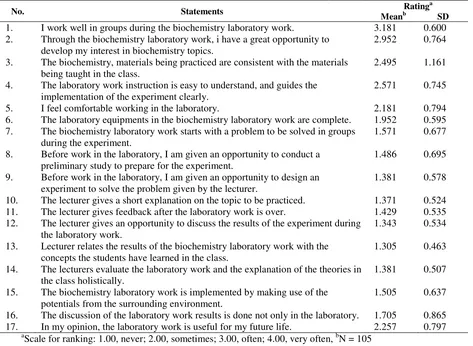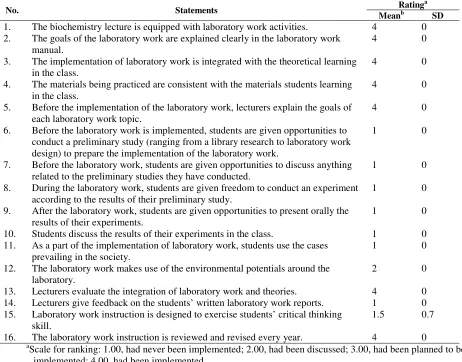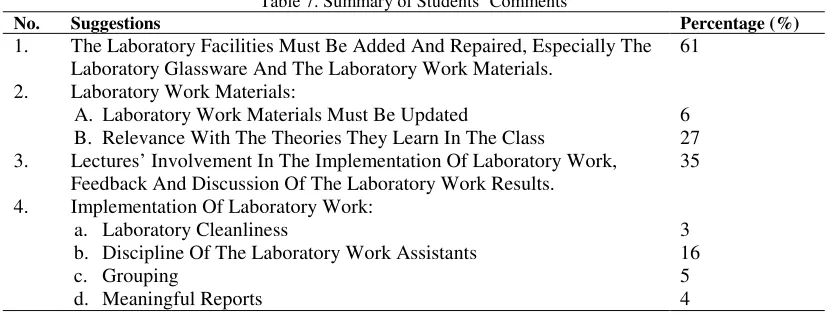Identification of the Students’ Critical Thinking Skills
through Biochemistry Laboratory Work Report
Yunita Arian Sani Anwar
1,a), Senam
2, and EndangW Laksono
2,b)1Study Program of Chemistry Education, Faculty of Teacher Training and Education, Mataram University,
Indonesia
2Departement of Chemistry Education, Faculty of Mathematics and Natural Science, Yogyakarta State University,
Indonesia
a)
Corresponding author: riananwar04@gmail.com
Abstract. This work aims to (1) identify the critical thinking skills of student based on their ability to set up laboratory work reports, and (2) analyze the implementation of biochemistry laboratory work. The method of quantitative content analysis was employed. Quantitative data were in the form of critical thinking skills through the assessment of students’ laboratory work reports and questionnaire data. Hoyo rubric was used to measure critical thinking skills with 10 indicators, namely clarity, accuracy, precision, consistency, relevance, evidence, reason, depth, breadth, and fairness. The research sample consisted of 105 students (35 male, 70 female) of Mataram University who took a Biochemistry course and 2 lecturers of Biochemistry course. The results showed students’ critical thinking skills through laboratory work reports were still weak. Analysis of the questionnaire showed that three indicators become the biggest problems during the laboratory work implementation, namely, lecturers’ involved in laboratory work implementation, the integration of laboratory work implementation of learning in the classroom has not been done optimally and laboratory work implementation as an effort to train critical thinking skills is not optimal yet.
INTRODUCTION
Critical thinking skill as a form of higher order thinking [1]. Critical thinking sounds like a dispassionate process, but it can engage emotions and even passionate responses [2]. Critical thinking skills aid emotional awareness so that people can communicate clearly in an appropriate manner [2,3].
Brookfield [4] revealed that critical thinking illustrates the process with the conditions of the students become aware of the two sets of assumptions. First, students investigate the assumption held by an expert in a field of study, i.e. lecturer. Second, students investigate their own assumptions in the frame of mind and actions of their own. Thinking critically placed a person in taking action based on the evidence to achieve the expected results. Critical thinking can also train a person to choose a good argument to accept reason and perform certain actions [5].
Laboratory work activity is the learning method that can provide stimulation, interest, attention to the students through the experience of the relationship between theory and the real world in everyday life [6]. Through the laboratory work, the student’s argument can be well developed [7]. It is expected that laboratory work is able to train high-level thinking skills, especially critical thinking skills.
The tendencies of laboratory work implementation in Indonesian, especially at the University of Mataram[10]: 1. Expository Method is more Dominant in Implementation
This method has a pattern like a cookbook that only confirms a special procedure to produce data. Students do not have the opportunity to start the experiment, practice thinking skills, as well as to be responsible in the group.
2. Not Integrated with Classroom Learning
Biochemistry laboratory work tends to be implemented after the delivery of the learning material in class, not as a part of classroom learning in class. Besides, faculty involvement in its implementation is still lacking. The occurring tendency is that laboratory work implementation is given to the laboratory staff and laboratory assistant.
3. Laboratory work Reports have not been considered as an important assessment
The ability to prepare laboratory work reports is not yet become an important assessment in the learning process. So far, the assessment activity tends to give scoring and value covering from the value of the initial response, the final report, and the final response. Assessment is left withthe responsibility of the laboratory assistant.
Biochemistry is one of the subjects that are difficult to understand thoroughly by learners [11,12]. At the University of Mataram, biochemistry laboratory work has been included in the lecture, but has not been able to improve critical thinking skills of the students learn in terms of the test results [10]. Feedback laboratory work report has not yet been made to improve students' critical thinking skills.
This study aims to (1) identify students’ critical thinking skills through their ability to write laboratory work reports, and (2) analyze the implementation of biochemistry laboratory work.
METHODOLOGY
Participant
Participants in this study consisted of students who attend college biochemistry and lecturer of biochemistry at the University of Mataram.Variations in the sample are shown in Table 1. All the students followed the laboratory instruction in these three topics, namely carbohydrate identification, protein identification, and fat identification. Students were writing laboratory work report based on traditional laboratory report writing format. This format included abstract, purpose, theory, materials, procedure, result and discussion, conclusion, and references.
TABLE 1. Summary of Sample Demographics (N = 105)
Sample Background Sub Total
Students Gender
Male Female
35 70
Year
2010 2011 2012 2013
1 2 4 98 Lecturer Gender
Male Female
1 1
Level of Education
Master Doctor
1 1
Instrument
Table 2: Modified Hoyo Critical Thinking Evaluation Rubric forLaboratory Work Reports
Score Criterion for obtaining levels (scores) of the rubric
Abstract Synthesis 3 All main points of information are succinctly presented. The title/purpose, hypothesis/ research question is clearly stated. The purpose is written in a professional way in less than 100 words long and contains a clear articulation of thesis statement or argument.
2 Some points of information or keywords are missing, but all the criteria are addressed.
1 One or more criteria are absent. Sources of
Information
Knowledge and Evaluation
3 Sources of information are appropriately cited in the document. A thorough search of the literature was conducted. The nature of the sources is judged to be appropriate. Citations are consistently formatted.
2 An effort on all criteria is shown.
1 One or more criteria are absent.
Organization Analysis 3 A clear section headings are used in the document.
Material is presented under the appropriate heading. Information is presented in reasonable amounts. There is a logical and coherent flow of information
throughout the document.
2 Either one of the last two criteria not met. Contains
clear section headings with relevant material in each section.
1 Requires major improvements on all criteria.
Relevance Knowledge and
Application
3 Appropriate scientific terminology is used. The writing
in the report integrates information from class, lecture, and activities into new material. The student can provide a link between theory and applications. 2 One criterion is lacking, but efforts on the other two are
shown.
1 Scientific terminology is used, but none of the other
criteria are met.
Content Comprehension 3 The student’s writing conveys new information in the
student’s own words. Concepts are correctly
understood. An appropriate depth of content is present. The writing in the report is simple and direct. The student writes in the active voice rather than passive voice.
2 The material in the report is not well understood, but
effort is shown towards comprehension.
1 The content is too broad. The focus is not on the
scientific aspect of the topic.
Presentation Evaluation 3 The report is well written in Indonesian and has a
professional appearance: typewritten, neat, and easy to read. All previous formative evaluations were
addressed. The presentation conforms to the required format.
2 Efforts on all criteria were made, but not fully
achieved.
Students’ and teachers’ perceptions were obtained using a questionnaire with six indicator assessments, namely laboratory work implementation in teaching biochemistry, the involvement of the lecturers in laboratory work implementation, the relevance of the laboratory work with the students' needs, integration of laboratory work implementation with learning in the classroom, laboratory work implementation in an effort to train critical thinking skills, and reciprocity between laboratory work implementation and the students’ thinking skills[13]. Validity of Hoyo rubric modified and questionnaires were tested by two experts.
Data Analysis
Indicators of critical thinking consist of clarity, accuracy, precision, consistency, relevance, evidence, reason, depth, breadth, and fairness which is calculated through the mean average component of the report as shown in Table 3. The research report was assessed by two evaluators. The final score is the average of scores of each indicator by 2 evaluators. In case the assessment score of the two evaluators greatly varies, the laboratory work reports will be assessed by a third evaluator. The average and standard deviation of each statement of the questionnaire were calculated.
Table 3: Intellectual Standards Embedded in Traits of Critical Thinking Evidenced in Students’ Written Reports
Intellectual Standards
Trait evaluated
Abstract Sources of
Information Organization Relevance Content Presentation
Clarity √ √ √ √ √
Accuracy √ √
Precision √ √ √
Consistency √ √ √
Relevance √ √ √ √
Evidence √ √
Reasons √ √
Depth √ √ √ √ √
Breadth √ √ √
Fairness √ √
RESULT
Identification of Critical Thinking Skills Based on Hoyo Rubric
Hoyo rubric categorized critical thinking skills into clarity, precision, accuracy, consistency, relevance, evidence, reasons, depth, breadth, and fairness. Averages of each critical thinking indicator are shown in Table 4.On average, each critical thinking indicator shows that students’ critical thinking skills developing laboratory work reports are still weak. The weakest indicators are the accuracy, relevance, and breadth.
Table 4: Mean Scores and Standard Deviations for Critical Thinking Indicators Based on Hoyo Rubric for Laboratory Work Biochemistry Reports
Intellectual Standards N Mean SD
Clarity 105 1.267 0.238
Laboratory Work Implementation Identification Based on Perception of Students and
Lecturers of Biochemistry Course
Identification of laboratory work implementation using a questionnaire given to the students and the lecturer of the biochemistry course. Average for each statement is shown in Table 5.
Table 5. Mean Scores and Standard Deviations for each Statement Based on Questionnaire for Students
No. Statements Rating
a
Meanb SD
1. I work well in groups during the biochemistry laboratory work. 3.181 0.600 2. Through the biochemistry laboratory work, i have a great opportunity to
develop my interest in biochemistry topics.
2.952 0.764 3. The biochemistry, materials being practiced are consistent with the materials
being taught in the class.
2.495 1.161 4. The laboratory work instruction is easy to understand, and guides the
implementation of the experiment clearly.
2.571 0.745 5. I feel comfortable working in the laboratory. 2.181 0.794 6. The laboratory equipments in the biochemistry laboratory work are complete. 1.952 0.595 7. The biochemistry laboratory work starts with a problem to be solved in groups
during the experiment.
1.571 0.677 8. Before work in the laboratory, I am given an opportunity to conduct a
preliminary study to prepare for the experiment.
1.486 0.695 9. Before work in the laboratory, I am given an opportunity to design an
experiment to solve the problem given by the lecturer.
1.381 0.578 10. The lecturer gives a short explanation on the topic to be practiced. 1.371 0.524 11. The lecturer gives feedback after the laboratory work is over. 1.429 0.535 12. The lecturer gives an opportunity to discuss the results of the experiment during
the laboratory work.
1.343 0.534 13. Lecturer relates the results of the biochemistry laboratory work with the
concepts the students have learned in the class.
1.305 0.463 14. The lecturers evaluate the laboratory work and the explanation of the theories in
the class holistically.
1.381 0.507 15. The biochemistry laboratory work is implemented by making use of the
potentials from the surrounding environment.
1.505 0.637 16. The discussion of the laboratory work results is done not only in the laboratory. 1.705 0.865 17. In my opinion, the laboratory work is useful for my future life. 2.257 0.797
a
Two aspects of the biochemistry laboratory work were assessed positively by the students (M>2.5) are (i) the students felt they were working well in groups on the laboratory work biochemistry in laboratory (M = 3.181) and (ii) students feel they have a great opportunity to increase their interest in the topic of biochemistry through laboratory work (M = 2.952).
A total of six aspects with the lowest average value (M<1.5), namely (i) the student’s opportunity to design an experiment before the laboratory work to solve the problem given by lecturer (M = 1.381), (ii) lecturer gave a brief description about the topics of laboratory work (M = 1.371), (iii) the lecturer gave feedback after laboratory work completion (M = 1.428), (iv) lecturers provide an opportunity to discuss the obtained experimental results (M = 1.343), (v) Lecturer relate the biochemistry laboratory work results with the concepts learnt in class (M = 1.305), and (vi) lecturer conduct integrated assessment of the laboratory work implementation with the learning theory in class (M = 1.381).
Analysis of the biochemistry lecturer’s questionnaire showed that the biochemistry course has been accompanied by a laboratory work, objective of the laboratory work had been described clearly in the laboratory instruction, laboratory work implementation had been integrated with the theory in the classroom instruction, there is conformity between laboratory work materials with the material presented in class, and before laboratory work begins, the objective for each practicum had been explained (Table 6).
Table 6. Mean Scores and Standard Deviations for each StatementBased on Questionnaire for Lecturers
No. Statements Rating
a
Meanb SD
1. The biochemistry lecture is equipped with laboratory work activities. 4 0 2. The goals of the laboratory work are explained clearly in the laboratory work
manual.
4 0
3. The implementation of laboratory work is integrated with the theoretical learning in the class.
4 0
4. The materials being practiced are consistent with the materials students learning in the class.
4 0
5. Before the implementation of the laboratory work, lecturers explain the goals of each laboratory work topic.
4 0
6. Before the laboratory work is implemented, students are given opportunities to conduct a preliminary study (ranging from a library research to laboratory work design) to prepare the implementation of the laboratory work.
1 0
7. Before the laboratory work, students are given opportunities to discuss anything related to the preliminary studies they have conducted.
1 0
8. During the laboratory work, students are given freedom to conduct an experiment according to the results of their preliminary study.
1 0
9. After the laboratory work, students are given opportunities to present orally the results of their experiments.
1 0
10. Students discuss the results of their experiments in the class. 1 0 11. As a part of the implementation of laboratory work, students use the cases
prevailing in the society.
1 0
12. The laboratory work makes use of the environmental potentials around the laboratory.
2 0
13. Lecturers evaluate the integration of laboratory work and theories. 4 0 14. Lecturers give feedback on the students’ written laboratory work reports. 1 0 15. Laboratory work instruction is designed to exercise students’ critical thinking
skill.
1.5 0.7 16. The laboratory work instruction is reviewed and revised every year. 4 0
a
Scale for ranking: 1.00, had never been implemented; 2.00, had been discussed; 3.00, had been planned to be implemented; 4.00, had been implemented
b
The lecturer gives meaning to the integration of theory and practice by combining the results of the assessment scores of assignments, midterm tests and final exams.The lecturer never gave an opportunity to the students to do a preliminary study, conducted discussions related to preliminary studies, or adjusted experiments to the laboratory work instruction. Topics were demonstrated more frequently by laboratory assistants and lecturer, and student never had a presentation and discussion on the results of experiments in the classroom. Laboratory work materials that can be found in the environment were not used, even though the possibility of using them was discussed. The lecturer did not give feedback on the laboratory work reports compiled by the students. Evaluation of laboratory work reports was conducted entirely by laboratory assistant. Even though laboratory work instruction is revised annually, it has not been designed to train students' critical thinking skills.
The researcher also assessed the students' comments regarding the biochemistry laboratory work implementation. The comments showed that there were four main factors of concern, related to a tool or laboratory facilities, laboratory work materials, faculty involvement, as well as the laboratory work implementation. Student comments, summaries are shown in Table 7.
Table 7. Summary of Students’ Comments
No. Suggestions Percentage (%)
1. The Laboratory Facilities Must Be Added And Repaired, Especially The Laboratory Glassware And The Laboratory Work Materials.
61 2. Laboratory Work Materials:
A. Laboratory Work Materials Must Be Updated 6 B. Relevance With The Theories They Learn In The Class 27 3. Lectures’ Involvement In The Implementation Of Laboratory Work,
Feedback And Discussion Of The Laboratory Work Results.
35 4. Implementation Of Laboratory Work:
a. Laboratory Cleanliness 3
b. Discipline Of The Laboratory Work Assistants 16
c. Grouping 5
d. Meaningful Reports 4
Observation of laboratory work implementation shows biochemistry laboratory work using an expository method in which students follow work instructions given by the lecturer of the course. Laboratory work implementation was carried out after the midterms in 2 to 3 hours of lectures. Students conduct laboratory work in a group with 5-6 members.
Laboratory work is a space that can build learners’ argument [7]. The ability to build the argument is one of the important critical thinking skills that the learners need to be trained [2]. Through the laboratory work, critical thinking skills can be developed, including the understanding of metacognitive [14]. The results of this study indicate laboratory work in teaching biochemistry has not been able to train students' critical thinking skills.
The use of expository laboratory for learning biochemistry at the University of Mataram is one of the causes that hindered the development of students’ critical thinking skills. There are four types of laboratory-based learning, namely expository, inquiry, discovery and problem-based[15]. This type of learning is distinguished by three descriptors, the outcome (results), approach and procedure (the employed procedure). These four laboratory-based learning are shown in Table 8. The outcomes of all types of laboratory-based learning is that it can be predetermined (can be determined) or undetermined (cannot be determined).
Table 9. Descriptors of The Laboratory Instruction Styles
No Types Description
Outcome Approach Procedure 1. Expository Predetermined Deductive Provided 2. Inquiry Undetermined Inductive Developed by
student 3. Discovery Predetermined Inductive Provided 4. Problem-based Predetermined Deductive Developed by
student
Laboratory work problem identification in accordance with the analysis of the questionnaire of students and lecturers includes (1) the implementation of laboratory work with learning activities in the classroom has not been integrated so that the involvement of lecturers of the subjects in the laboratory is very low, (2) cookbook laboratory is still dominating so the laboratory work activity is less able to train critical thinking skills of the students, (3) laboratory work reports have not become an important assessment so that students do not have a chance to improve their writing skills.
Effective laboratory work implementation is done by integrating learning theories and experiments in the laboratory [19,20]. In addition, the expository method needs to be reduced by using the methods of inquiry, discovery, or problem-based learning more frequently. Cookbook laboratory has practicum stages that remove stage of designing the investigation and give priority to the processing and interpretation of data [21].
According to Reid & Shah [22], the working principles of effective laboratory in higher education in which (1) integrative, (2) efficient, and (3) practical, (4) able to train students' ability in terms of developing hypotheses, solving problems, using knowledge and skills in different situations, designing a simple research to prove the hypothesis, using laboratory skills in carrying out experiments, interpreting experimental data, clearly explaining the experimental results, and recalling the critical ideas based on experimental results in the long term. In addition, the use of the environment concept becomes important in establishing the students’ concept of science [23]. Hence, the expository method needs to be reduced in laboratory work in a university.
Effective laboratory work is able to train students to apply the concept of inductively through observing and collecting data in order to build a long-term concept [5]. The formation of the concept in the long term shows the learning process has been established effectively [4].
Some research suggests the use of laboratory that trains students to think may improve cognitive abilities, interests and motivation. Ketpichainarong et al. [24] found that the use of laboratory inquiry can improve the cognitive abilities of the students. Not only cognitive abilities, but also the interests of learners can be increased through laboratory inquiry [23]. Laboratory work with such an inquiry can improve students' writing ability [25]. Besides inquiry, laboratory work with PBL method can also improve students' critical thinking skills and made a course meaningful [26,27].
CONCLUSION
Students’ critical thinking skills developed through the ability to laboratory work reports on biochemistry course at the University of Mataram is still low on the components of information source, relevance, organization, and content. Identification of the laboratory work issues in accordance to the students’ and lecturers’perception, the laboratory work is not yet integrated with learning theory in the classroom, cookbook laboratory is still dominating, and students' writing ability training is not sufficient.
RECOMMENDATION
ACKNOWLEGMENT
The authors thank to Kemenristek DIKTI, due to the funding of Penelitian Disertasi Doktor-2017 for this work.
REFERENCES
1. F.J. King, L. Goodson, and F. Rohani. Educational Services Program, www.cala.fsu.edu, (2011). 2. S. Cottrell. Critical Thinking Skills, (Palgrave Macmillan, 2005) p. 1-3.
3. J. Moon. Critical Thinking: An Exploration of Theory and Practice, (Routledge Taylor & Francis Group: New York, 2008) p. 5-8.
4. S.D. Brookfield. Teaching for critical thinking: tools and techniques to help students question their assumptions, (jossey-bass a wiley imprint: San Francisco, 2012) p. 157.
5. T. Bowell, and G. Kemp. Critical thinking: a concise guide, (Routledge taylor& francis group: London and New York, 2002) p. 35.
6. C. Ottander, and Grelsson. Journal of Biology, 40(3), 113-118, (2006).
7. A. Hofstein, M. Kipnis, and P. Kind. Science Education Issues and Development, 1, 59–94, (2008). 8. M.T. Hoyo. Journal of Chemical Education, 80 (8), 899–903, (2003).
9. T. Gupta, (Doctoral Disertation, Iowa State University), “Guided-inquiry based laboratory instruction: investigation of critical thinking skills, problem solving skills, and implementing student roles in chemistry” (2012). Doctoral.
10. Y.A.S. Anwar, E. Junaidi, and S.W. Al Idrus. PAEDAGORIA Jurnal Kajian Penelitian dan Pengembangan Kependidikan, 8(2), 71 –74, (2013).
11. J. Varghese, M. Faith, and M. Jacob. BMC Medical Education, 12(21), 1–9, (2012). 12. K. Broman, M. Ekborg, and Johnels. Nordina, 7(1), 43-53, (2011).
13. Y.A.S. Anwar, Senam, and E. Widjajanti LFX. Not Publication, (2016).
14. J.L. Kincheloe. Knowledge and critical pedagogy, (Springer : New York, 2008) p. 25. 15. D.S. Domin. Journal of Chemical Education, 76(4), 543-547, (1999).
16. N. Mbajiorgu, and N. Reid. Factors Influencing Curriculum Development in Chemistry. Hull: Royal Society of Chemistry, (2006).
17. A. Gomez-Garay, E.P. Carril, L.M. Calvarro, A.A. Garcia, and B.P. Lopez. Learning in the Laboratory: Experiences in an Hybrid Between the Expository and the Inquiry Laboratories. Proceedings of INTED 2013 Conference 4th-6th March 2013, Valencia, Spain, (2013).
18. E.A. Sigler, and J. Saam. Journal The Scholarship of Teaching and Learning, 7(2), 22–31, (2007). 19. D. Gabel. Journal of Chemical Education, 76(4), 548–553, (1999).
20. V. Talanquer. International Journal of Science Education, 33(2), 179–195, (2011). 21. J. Copriady. Asian Journal of Scientific Research, 8(1), 22–40, (2015).
22. N. Reid, and I. Shah. Chemistry Education Research and Practice, 8(2), 172–185, (2007). 23. A. Hofstein, and V.N. Lunetta. Science Education, 88(1), 28–54, (2004).
24. W. Ketpichainarong, B. Panijpan, and P. Ruenwongsa. International Journal Environmental & Science Education, 5(2), 169-187, (2010).
25. J.P. Walker, and V. Sampson. Journal of Chemical Education, 90, 1269–1274, (2013).
26. A.M. Liceaga, T.S. Ballard, and B.J. Skura. Journal Food Science Education, 10, 19–22, (2011).
